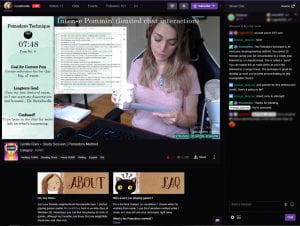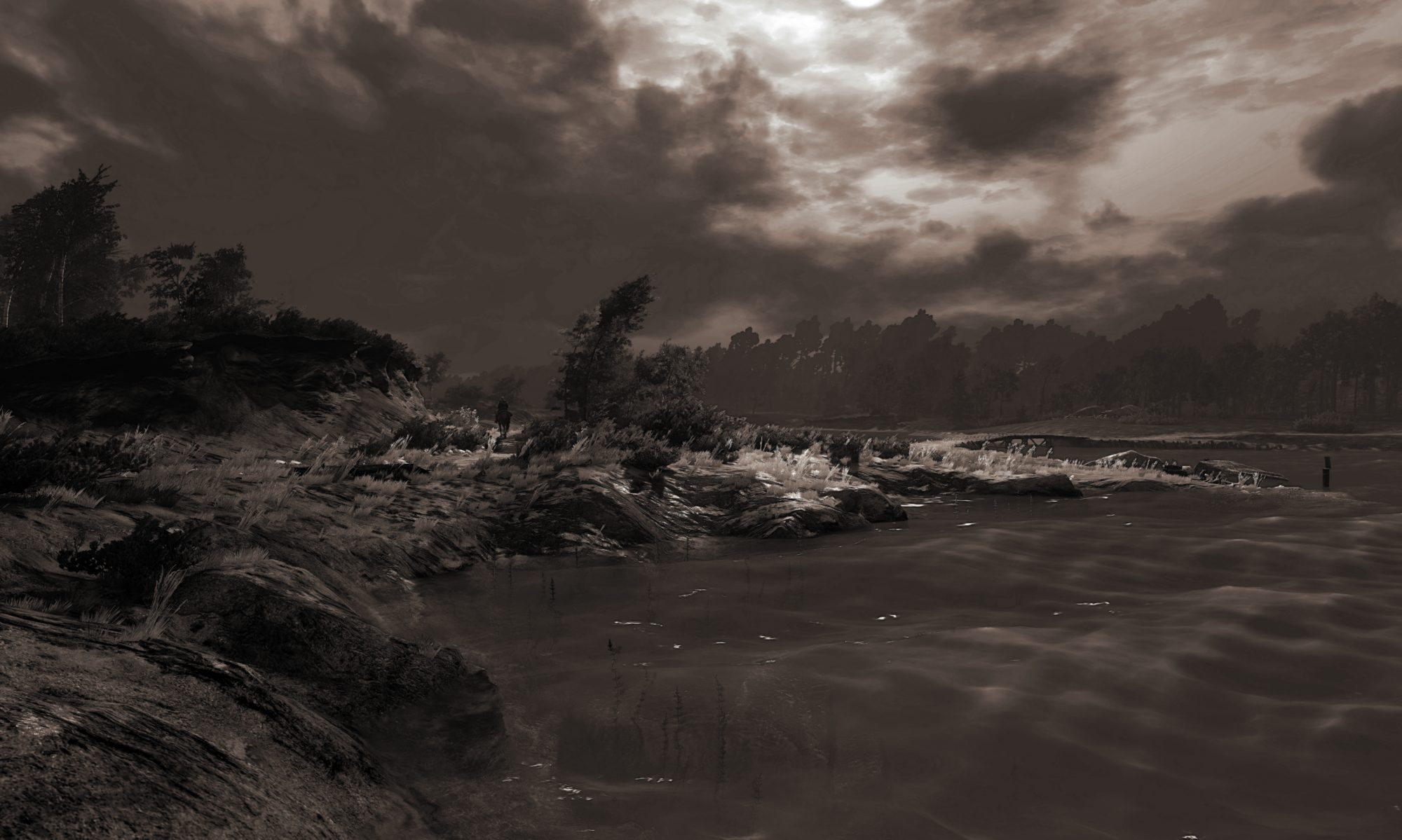Preliminary Reflections on Live-streaming and Platform Pedagogies
by Kristopher Purzycki
This is an abridged version of a presentation given at the Computers & Writing Conference, Michigan State University, 2019.
My interest in Twitch comes not from my gaming scholarship but from an interest in broadcasting. I’ve always been attracted to those media that enable the public to cast a wide net to an audience. From guerrilla journalism to pirate radio to mainframe shareware, my interests always turn to those that offer an open, accessible platform to a general public. So live-streaming, which essentially combines the social interaction of talk radio with public access cable television, seems to serve in this capacity.
Fascinated by this aspect of Twitch, I started experimenting with how the platform could be used. One of these experiments involved writing a dissertation chapter which I had been having a difficult time initiating. Knowing that successful Twitch streaming entailed a regular schedule, I dedicated several three-hours sessions during the week to writing while live-streaming. Surprisingly, this worked for several weeks and I was able to complete a decent chapter draft shortly thereafter. Along the way, a number of people became regulars and would pop in whenever I began streaming. Dutch philosophers and Midwestern game scholars popped in for a visit, oftentimes offering resources that might help whatever passage I had been working on.
At the same time I also began attracting novice writers. Many visitors seemed to just want to be to witness the activity of writing. As one regular noted, “we’re not here for your writing, we’re here for your company.” And so an amorphous circle or writers formed, dispersed, connected not by theme, discipline, or level of expertise but by platform. I began receiving requests to review short passages. Links to pages of prose were sent to me. I would receive invites to check out others’ writings on their own streams. By the third week of writing, I was spending less time working on my own writing and more time helping others with theirs. And I liked it. For the sake of finishing the project, I stepped away from streaming for some time. Signaling a return to a project I’d held off on, I streamed my dissertation defense on May 20th of this year.
 With this in mind, it may make more sense why a cohesive writing community exists on Twitch. It’s contributors range from amateur fan-fic creators to doctoral students. “Rexadoodle,” for example, studies for her doctoral preliminary exam in economics on stream. Using the pomodoro technique, rexadoodle is able to focus on specific tasks while limiting chat with the audience (of course, I discovered this after interrupting with an introduction). Rexadoodle averages over 20 viewers at a time who wait patiently for her to finish her 20-minute writing sessions. Conversation ensues at the onset of each break but, as far as I could tell, never discussed the act of writing. Most interestingly, this streamer does this as part of the ASMR Twitch category, or those shows that evoke an “autonomous sensory meridian response” that is aroused when receiving personal attention. At the time of this writing, I’m unsure how these two imperatives operate together.
With this in mind, it may make more sense why a cohesive writing community exists on Twitch. It’s contributors range from amateur fan-fic creators to doctoral students. “Rexadoodle,” for example, studies for her doctoral preliminary exam in economics on stream. Using the pomodoro technique, rexadoodle is able to focus on specific tasks while limiting chat with the audience (of course, I discovered this after interrupting with an introduction). Rexadoodle averages over 20 viewers at a time who wait patiently for her to finish her 20-minute writing sessions. Conversation ensues at the onset of each break but, as far as I could tell, never discussed the act of writing. Most interestingly, this streamer does this as part of the ASMR Twitch category, or those shows that evoke an “autonomous sensory meridian response” that is aroused when receiving personal attention. At the time of this writing, I’m unsure how these two imperatives operate together.
One facet of Twitch that certainly stokes this response is the incorporation of a tipping economy. In Twitch, this is embodied in the use of bits that are given through chat. These bits animate your chat input, essentially making your voice stand out in the chat window. Bits earn streamers 1 cent per bit. For the spectator, bits currently cost $1.40 per 100 bits. According to a 2017 Variety piece, Twitch raked in over $12 million in a ten-month period (Spangler). During a break in a recent writing session, rexadoodle received numerous “cheers” from spectators. During this break, two spectators competed for the title of “Top Cheerer.” This week, over 10000 bits ($126 in value) had been given between the two, earning rexadoodle an $100.
While I don’t anticipate such vying for tutoring attention, it’s tempting to consider what sort of alternative economy this opens up for those in higher education, many of whom are poorly paid and/or insecure in their field. Being one of these, I’m currently experimenting with a system where I offer tutoring services across a live-streaming platform. One of the numerous issues that has inhibited this is the intellectual property rights of both myself and students. Another is ensuring that the system of communication maintains privacy, compliance with FERPA regulations, as well as pedagogical ethics. Much of my own hand-wringing occurs where the public institution meets the capitalist platform. How to preserve a creative commons license on my intellectual property on a platform where that’s unavailable? YouTube provides this option but is a much less accessible platform focusing even more on games than Twitch.
Other live-streaming experiences have continued to reinforce my predication that live-streaming will be a tremendous boon for higher ed. In June, I was able to play Occupy White Walls with Dr. Kyle Bohunicky (University of Florida) and the Looking for Good streaming group. This was an incredible experience that demonstrated just how potent live-streaming can be for education and collaboration.
For my most recent experiment, I live-streamed one of the panels I presented with at the Computers & Writing conference, held at Michigan State University in June of this year. With the approval of Dan Hocutt and Megan Mize, we broadcast the entire panel on Twitch. Most in the audience were unphased (or unimpressed) with this – a few (notably younger) in the audience were far more intrigued by the motivations of streamers and how those “desires” could be tapped into by educators.
Still, we didn’t receive any questions across the stream, as I had hoped. Yet there were a few viewers and the tech held up on the conference center’s WiFi. Let’s chalk that up as a win for now.
Based on these experiences, it seems clear to me that there is great potential for live-streaming in higher education. While streaming my dissertation, people would join the stream to see how much progress had been made. I maintained a word count and shared daily and weekly goals as it was one of the more common;y requested updates. As I mentioned, other scholars suggested works to pick up – some of which turned out to be invaluable to the project. In addition to revealing the raw writing process, streaming can also potentially dispel the fog of higher eds more cryptic practices. After live-streaming my defense, one person thanked me for sharing the experience noting that it had helped him understand what exactly a defense was. But what other rites and rituals of the academy can be opened up through live-streaming? How can this service, for example, enable participation by those with limitations of mobility (or funding)?
Given the rapidity that live-streaming has developed into a lucrative platform of considerable breadth, it might be surprising that the medium has not branched its way into more fields. Yet Twitch, which once offered a vehicle for everything from gaming to performance art, is no longer interested in catering to a diversity of interests nor providing a stage for participatory culture. Categories are limited to those that possess the better capacity for providing Amazon the most profit. So while this motivation it not surprising, what is odd is that Amazon hasn’t taken more steps to usurp education in some way: “Want to pick up this work being referenced by StarLord789? Here’s a link to a used copy.”
Setting aside this low-hanging critique for the time being, we may want to ready ourselves. There are opportunities to be had on both sides of the lectern. Yet there are also numerous considerations and concerns. Admittedly, the ones I offer here are only those encountered in my own experience, which is limited in scope. Despite this trepidation, I find it difficult to imagine any other future than one where one can receive a humanities degree from Amazon.edu or Google Online University, where the curriculum is bound to products and proprietary services.
Given the current state of higher education, maybe this future isn’t much different after all.
Slides from the presentation can be found here. This presentation was also live-streamed via Twitch and can currently be found on my YouTube channel.
Works Cited in Original Paper
Rexadoodle. Twitch.tv. Accessed 17 June 2019. https://www.twitch.tv/rexadoodle
Looking for Good. Twitch.tv. Accessed 17 June 2019. https://www.twitch.tv/lfgatuf
“FAQs on Photos and Videos under FERPA.” FAQs on Photos and Videos under FERPA | Protecting Student Privacy, studentprivacy.ed.gov/faq/faqs-photos-and-videos-under-ferpa.
Hamilton, William A et al. “Streaming on Twitch: Fostering Participatory Communities of Play within Live Mixed Media.” Proceedings of the 32nd annual ACM conference on Human factors in computing systems. ACM, 2014
Handrahan, Matthew. “Any Henning: Streaming must be more than ‘just an invisible console.” gamesindustry.biz. 24 April 2019. Accessed 14 June 2019. https://www.gamesindustry.biz/articles/2019-04-24-amy-hennig-streaming-must-be-more-than-just-an-invisible-console
Oldenburg, Ray. The Great Good Place. De Capo Press, 1999.
Payne, Keith, Schuetzler, and Giboney. “Examining the Learning Effects of Live Streaming Video Game Instruction over Twitch.” Computers in Human Behavior 77.C (2017): 95-109. Web.
Spangler, Todd. “Twitch Will Let More Streamers Earn Money, After Users Spend Over $12 Million on Cheering Emoji.” Variety.com. 21 April 2017. Accessed 19 June 2019. https://variety.com/2017/digital/news/twitch-affiliate-program-cheering-12-million-dollars-1202392024/
